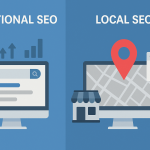If you’re running a local business or managing SEO for one, you’ve probably asked yourself at some point: What actually moves the needle when it comes to local search rankings? The answer? You don’t have to guess anymore—A/B testing is your best friend.
Local SEO A/B testing is a game-changer. It helps you make data-driven decisions, not just assumptions. Instead of throwing SEO changes at your website and hoping something sticks, A/B testing allows you to test what actually works. Let’s walk through everything you need to know to get started.

What is Local SEO A/B Testing?
Local SEO A/B testing is the process of comparing two versions of a webpage or local SEO element—like a title tag, business description, or call-to-action—to see which one performs better in local search results.
Instead of guessing what might improve your rankings or clicks, you test one small change at a time and measure the results. For example, you might test two different headlines on a location page to see which attracts more clicks or ranks higher in your area.
It’s a simple yet powerful way to figure out what really works for your business—based on real data, not assumptions.
What to Look For When Running Local SEO A/B Tests
Now, not every change is worth testing. You want to be intentional. Here’s what to focus on when planning your A/B tests:
1. Test One Variable at a Time
If you change multiple things at once (like your page title and your meta description), you won’t know what actually caused the results. Keep it simple—test one change at a time.
2. Start with High-Impact Elements
Some changes matter more than others. Focus on testing elements that can directly influence local rankings or user engagement:
-
Title tags with location keywords
-
Business hours and open-now indicators
-
Review snippets
-
Address formatting on NAP (Name, Address, Phone number) listings
3. Use Pages with Enough Traffic
Your location-specific pages or Google Business Profile should get enough traffic to run a meaningful test. Without enough visitors, your results won’t be statistically valid.
4. Track the Right Metrics
Decide what success looks like. Are you tracking:
-
Local map pack rankings?
-
Organic clicks from a certain area?
-
Click-through rates from local search?
-
Driving direction requests or phone calls?
Pick a measurable goal before launching the test.
Why Use A/B Testing for Local SEO?
You might be thinking, “Can’t I just follow local SEO best practices?” Sure, you can—but here’s why Local SEO A/B Testing takes things to the next level:
1. It Removes the Guesswork
SEO can often feel like a black box. A/B testing puts data on your side so you can stop guessing what works and start knowing what drives real results.
2. It Improves ROI
Time is money, and so is traffic. Instead of wasting months on changes that don’t work, A/B testing helps you get the most out of every update.
3. It Helps You Stand Out Locally
Your competitors are likely doing the same SEO basics. A/B testing helps you find what works uniquely for your business in your specific area.
4. You Learn What Your Audience Wants
Sometimes, you’ll discover insights you weren’t expecting—like users preferring a certain call-to-action wording or layout. Those small details can boost conversions.
How to Use A/B Testing to Optimize Local SEO
Ready to put this into action? Here’s a beginner-friendly roadmap to start A/B testing for better local rankings:
Step 1: Choose What to Test
Pick one element to test. For example:
-
Title Tag A: “Best Pizza in Austin | Joe’s Pizzeria”
-
Title Tag B: “Joe’s Pizzeria – Award-Winning Pizza in Austin”
Decide which one you think will perform better, but be ready to be surprised.
Step 2: Set Up the Test
There are a few ways to run A/B tests for SEO:
-
Use SEO testing tools like SearchPilot, SEOTesting.com, or Google Optimize (for UX testing).
-
Create two similar pages with slight variations (ideal for multi-location businesses).
-
Or test changes on a group of pages (like 10 location pages) versus another group.
Make sure your test pages are indexed and follow the same structure, except for the one variable you’re testing.
Step 3: Monitor the Metrics
Use tools like:
-
Google Search Console – for clicks and impressions
-
Google Business Profile Insights – for local engagement
-
Local Falcon or BrightLocal – to track local rankings on a map grid
-
Google Analytics – for conversion tracking
Measure your results for at least 2–4 weeks, depending on your traffic volume.
Step 4: Analyze the Results
Did Version A get more clicks, higher rankings, or more direction requests? If yes, great! You’ve got a winner. If not, test again—every test gives you insight.
Keep a testing journal to track what you’ve tried and what worked. Over time, this builds a powerful local SEO playbook customized to your business.
Step 5: Roll Out Winning Variations
Once you’ve found a version that performs better, roll it out across all applicable pages or listings. Then repeat the process with a new element.
Remember: Local SEO A/B testing isn’t a one-time thing. The more you test, the better your results will get.
Examples of Local SEO A/B Tests You Can Try
Need inspiration? Here are some easy and impactful A/B tests to kick things off:
-
Test different formats of your location in the title tag
“Dentist in Brooklyn” vs “Brooklyn Dentist” -
Experiment with customer review widgets
Displaying them above the fold vs. below -
Compare CTA wording
“Book an Appointment” vs “Schedule Your Visit Today” -
Try different NAP placements on your homepage
Footer vs. header vs. sidebar -
Change your Google Business Profile description
Emphasize specialties like “family-owned” or “emergency services available”
Each test can give you deeper insight into what your audience responds to.
Start Testing, Start Ranking
Local SEO isn’t just about keywords or directory listings anymore—it’s about making smart, strategic moves that drive real results. And Local SEO A/B Testing gives you the power to do exactly that.
By experimenting with small changes and tracking what works, you’ll uncover what truly resonates with your local audience. Over time, this leads to higher rankings, more local traffic, and more customers walking through your doors.
So instead of making random updates and hoping for the best, take a focused, test-and-learn approach. Start with one simple change this week—whether it’s your title tag, CTA, or business description—and watch how even small tweaks can lead to big gains.
If you want to take your local SEO efforts to the next level, Woosellservices can help!
Need help getting started? Reach out anytime. We’re here to help you grow smarter and faster in your local market.
Interesting Reads:
How to grow an online community from scratch?
What Is Off-Page SEO? Proven Techniques to Drive Organic Growth




